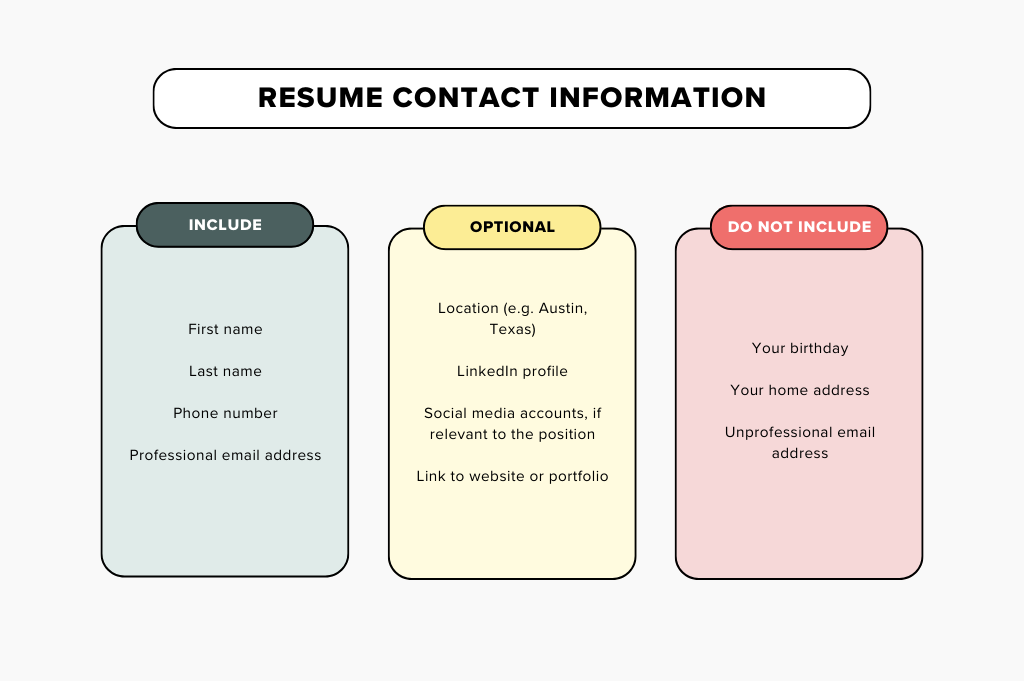Your resume is a chance to make a first impression on an employer. And that first impression matters, considering in the world of hiring, recruiters only spend mere seconds scanning each resume.
Because of this, formatting your resume in a clear and easy-to-read manner is important. A well-organized layout with clearly defined sections, bullet points, and consistent formatting makes it easier for recruiters to quickly grasp your qualifications and experiences. On top of that, it also demonstrates your attention to detail and ability to communicate effectively.
By presenting information in a concise and accessible format, you increase the likelihood of capturing recruiters’ attention— and making it to the next step of the hiring process.
What is the best resume format?
For most, listing your experience in reverse-chronological order will be the best resume format choice. This allows your most recent experience to shine.
However, it’s not the only way to order your resume. Here’s the difference between reverse-chronological and functional resumes.
Reverse-chronological resume
This format lists your work experience in reverse chronological order, starting with your most recent job and working backward. It highlights your career progression and is ideal for those with a consistent work history in the same field or industry.
Again, this is the most common resume format. When in doubt, use this one!
Functional resume
Functional resumes are a less common format but are still good for certain situations.
Instead of focusing on your chronological work history, this format resume emphasizes your skills and accomplishments, putting the most important and relevant roles first. It’s useful when:
- You’re changing careers: If you’re making a major career pivot, you may want highlight skills and achievements from previous roles that aren’t necessarily your most recent ones.
- You have career gaps: Maybe you have some gaps in your employment that you don’t want to call attention to. A functional format showcases your relevant skills, not the duration of work.
- Your experience doesn’t come from traditional work: Perhaps the experience that makes you a good fit for the role isn’t a traditional job. Including it in your work experience can bring that to the forefront.
Remember— a resume is supposed to summarize your career journey and skillset. Choose the option that best tells your story.
Should you list your education or job experience first?
Which comes first— your job experience or education? The answer depends on where you are in your career.
The best resume format for recent grads
If you’re recently out of college or high school, lead with your education. You may have little to no work experience yet, and that’s okay!
Start with your name and contact information, and then dive right into your academic history. You can include:
- Degree
- Major or concentration
- Years attended or anticipated graduation date
In this section, you can also list relevant coursework that you completed. After that, include relevant experience you have like being a member of a club, internships, or jobs you held while in college or high school.
Lastly, you can include a section at the bottom that outlines your hard and soft skills and certifications.
The best resume format if you have years of work experience
If you’ve been out of school for more than three years or so, lead with your experience. What you’ve accomplished in your professional career will be more important than the clubs and or organizations you were involved with in college.
Start with your most recent job experience and work your way back in chronological order. Be sure to add a few bullet points to each job to outline your major accomplishments and duties.
After you cover your experience, you can list relevant hard and soft skills and certifications. If you have room left, touch on your educational background.
Resume format FAQs
Here are quick answers to common questions that applicants have about resume formatting.
Should you put a picture on your resume?
You may find that some resume templates allow you to include a photo of yourself. It may seem like this would be a good way to let employers get to know you a little better, but most recruiters actually recommend against doing this for a number of reasons.
- Photos could introduce unconscious bias: Unconscious biases are ingrained stereotypes and attitudes that affect our actions, decisions, and understanding of the world around us on a subconscious level. Including a photo gives employers the opportunity to make assumptions about you based on your appearance.
- Images are not ATS-friendly: Today, many companies use applicant tracking systems, which help them manage job applications. The automated systems analyze resumes and help recruiters and hiring managers find the best fits for the job.
- They distract from what’s important: According to an eye-tracking study, recruiters, on average, only skim a resume for 7.4 seconds. You want to be sure they’re looking at what counts— your skills and experience!
When in doubt, leave it out!
Do you need to put your objective on your resume?
You may have also seen resume templates that include an objective.
Unless it is specifically requested, you should leave this off your resume.
Recruiters and hiring managers know what your objective is— to get the role! Since resumes should be no more than one page long, it’s important to use the space wisely. Don’t waste valuable real estate by stating what they can already infer. If you really feel it necessary to talk about your career objectives, mention it in your cover letter.
Should I use a creative resume template?
Looking to fill your resume with color, aesthetic fonts, and a little graphic design? If you’re applying to a role that is creative in nature, say a content creator or social media marketer, your format can allow for a little bit more creativity. This could be a good opportunity to showcase your artistic side and demonstrate the visual style you bring to the table.
However, if you’re looking for a more standard role, you’ll probably want to stick with a standard resume. Too many bells and whistles that are irrelevant to your role may distract the recruiter from what matters on the paper.
What should I leave off my resume?
You often hear what should go on your resume— but what should you leave off?
- Old and irrelevant job experiences: If you are several decades into your career, you don’t need to include your summer job from high school. Only include the last 10-15 years of experience on your resume.
- Personal information: Your resume doesn’t need to include information like your age, date of birth, home address, marital status, or whether or not you have children.
- Reasons for leaving previous job(s): Your resume is no place to go into detail about why you are seeking employment elsewhere.
If you want to go into more detail about your passions, talk about your enthusiasm for the role you’re applying, or address any potential concerns, consider submitting a cover letter.

How should I format my resume if I have no work experience?
Not having work experience doesn’t necessarily mean having a blank resume. You can include a number of life experiences on your resume, including:
- Internships
- Self-employed experience
- Volunteer work
- Clubs and activities
Each of these types of experiences can provide valuable skills and knowledge that your future employer is looking for!
Tell your story with your resume format
The best format for you depends on your unique circumstances, career goals, and the specific job you’re applying for. Whether you opt for the chronological or functional format, the key lies in effectively showcasing your skills, experiences, and achievements in a format that’s easy for recruiters to digest.
Remember, your resume is your personal marketing tool, so take the time to tailor it to each job application and ensure it reflects the best version of yourself!
